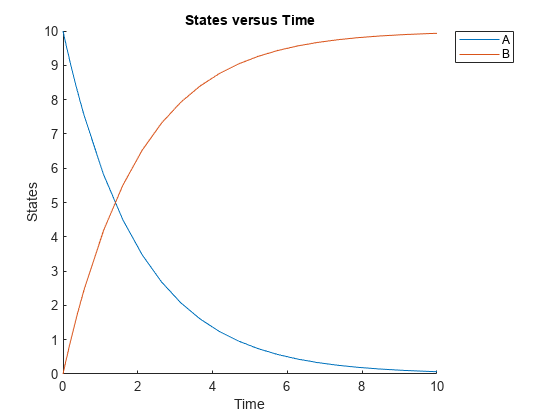SimBiology.Model
Model and component information
Description
The SimBiology.Model object represents a
model, which is a collection of interrelated reactions and rules that
transform, transport, and bind species. The model includes model components such as
compartments, reactions, parameters, rules, and events. Each of the components is represented
as a property of the model object. A model object also has a default configuration set object
to define simulation settings. You can also add more configuration set objects to a model
object.
The object properties define the characteristics of an object. Use the getset
You can retrieve SimBiology® model objects from the SimBiology root object. A SimBiology model object has its Parent property set to the SimBiology root object. The root object contains a list of model objects that are
accessible from the MATLAB® command line and from the SimBiology apps. Because both the command line and the apps point to the same model object
in the Root object, any changes you make to the model
at the command line are reflected in the apps, and vice versa.
Creation
Use sbiomodel to create a
SimBiology.Model object.
Properties
Object Functions
addcompartment | Create compartment object and add to model or compartment |
addconfigset (model) | Create configuration set object and add to model object |
adddose | Add dose object to model |
addevent (model) | Add event object to model object |
addobservable | Add observable object to SimBiology model |
addparameter | Create parameter object and add to model or kinetic law object |
addreaction | Create reaction object and add to model |
addrule | Add rule object to model |
addspecies | Create species object and add to model or compartment |
addvariant (model) | Add variant to model |
copyobj | Copy SimBiology object and its children |
createSimFunction | Create SimFunction object |
delete | Delete SimBiology object |
display | Display summary of SimBiology object |
export (model) | Export SimBiology models for deployment and standalone applications |
findUnusedComponents (model) | Find unused species, parameters, and compartments in a model |
generateCode | Generate MATLAB function to recreate SimBiology model |
get | Get SimBiology object properties |
getadjacencymatrix (model) | Get adjacency matrix from model object |
getconfigset (model) | Get configuration set object from model object |
getdose (model) | Return SimBiology dose object |
getequations | Return system of equations for model object |
getstoichmatrix (model) | Get stoichiometry matrix from model object |
getvariant (model) | Get variant from model |
removeconfigset (model) | Remove configuration set from model |
removedose (model) | Remove dose object from model |
removevariant (model) | Remove variant from model |
rename | Rename SimBiology model component and update expressions |
reorder (model, compartment, kinetic law) | Reorder component lists |
set | Set SimBiology object properties |
setactiveconfigset (model) | Set active configuration set for model object |
verify (model, variant) | Validate and verify SimBiology model |

